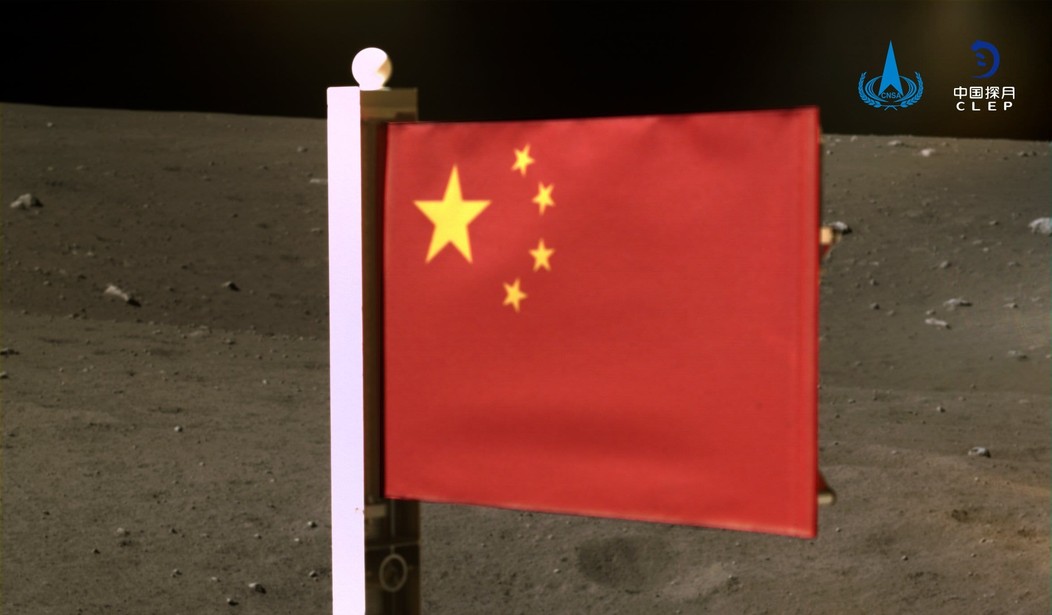An unmanned Chinese moon lander is on its way back to earth after collecting several pounds of moon rocks and leaving behind something to remember them by.
A Chinese Communist flag.
On the way home! #ChangE5 blasted off from the #moon with the lunar samples.
Have a safe journey home! pic.twitter.com/54PJSd4CjP
— Hua Chunying 华春莹 (@SpokespersonCHN) December 4, 2020
#Chinese national flag on the moon now. pic.twitter.com/Jv7gN3ytw1
— Rita Bai Yunyi (@RitaBai) December 4, 2020
Well, at least it’s not the hammer and sickle.
And I don’t think there are too many questioning whether the commie flag is sitting on a soundstage in Hollywood.
If there is no wind on the moon why is the US flag flaring like that? Photo taken from BBC @NASAMoon pic.twitter.com/pr1xTIeRpP
— Mikael Shik (@mikeshik7) December 4, 2020
China becomes the third nation to have landed a spacecraft on the moon and carried back samples of moon rocks. In addition to the U.S., the Soviet Union had a successful sample-return mission in 1972.
Chang’e 5’s unmanned mission was the latest in a series that comprises the Chinese Lunar Exploration Program. Departing with a load of lunar rocks, the mission represented the first time a spacecraft tried to return moon samples since the Soviet Union did it in the 1970s.
NASA Associate Administrator Thomas Zurbuchen congratulated China on its landing which took place Tuesday.
“Congratulations to China on the successful landing of Chang’e 5,” Zubuchen tweeted.
Congratulations to China on the successful landing of Chang’e 5. This is no easy task. When the samples collected on the Moon are returned to Earth, we hope everyone will benefit from being able to study this precious cargo that could advance the international science community. pic.twitter.com/2xoKouf3dq
— Thomas Zurbuchen (@Dr_ThomasZ) December 1, 2020
So is China getting ready to launch people to the moon? Not exactly. China does not possess the heavy-lift capability in its rockets that would be required to send people to the moon. The Apollo Saturn V rocket provided 9 million pounds of thrust at takeoff. The Chinese Long March booster can get a satellite into high-earth orbit but not much farther.
China doesn’t expect to send a crewed mission to the moon for a decade.
China is a generation behind the United States and Russia in its space exploration efforts. But its secretive, military-linked space program is quickly developing. Among its space projects are a robot explorer on the way to Mars, development of a reusable space plane and a planned human mission to the moon.
Kathleen Campbell is an astrobiologist and geologist at The University of Auckland in New Zealand. She told The Associated Press that the next 10 years will be “quite critical” in space exploration.
“This is where we’re going to transform out of near Earth orbit and back into what people will call ‘deep space,’” Campbell said.
And NASA isn’t ready to do that. The American space program is hopelessly bogged down with design flaws, lack of funding, and cost overruns. The moon mission, now planned for 2024, is supposed to be a prelude to a manned Mars mission in the early 2030s — if the immense problems with keeping humans alive in space for two years can be overcome. That remains to be seen.
DNI Ratcliffe: China Is ‘The Greatest Threat to America Today’










Join the conversation as a VIP Member